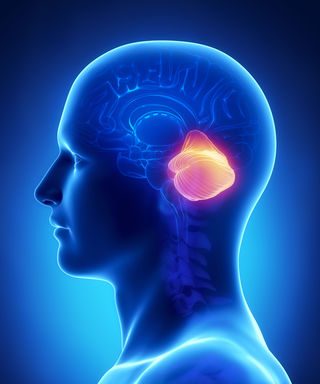Addiction
This Is Your "Little Brain" on Cannabis
Two systematic reviews unearth potent effects of cannabis on the cerebellum.
Posted March 9, 2019

Increasingly, our “little brain” is being recognized as playing a bigger role than previously thought in cognition, learning, emotions, and addiction. Because human cerebellum has a high density of CB1 cannabinoid receptors, there is speculation that cannabis use most likely affects both cerebellar function and structure. In recent months, two different systematic reviews have done deep and detailed dives into how cannabis affects the cerebellum.
The first review, from January 2019, “The Cerebellum, THC, and Cannabis Addiction: Findings from Animal and Human Studies,” was published in The Cerebellum journal. This review (Moreno-Rius, 2019) analyzed previous studies on human subjects and animal models that had identified various ways that cannabis affects the cerebellum. The author of this review also looked at how cannabis-related changes to the cerebellar structure and functional connectivity might influence addictive behaviors.
Josep Moreno-Rius summed up his findings in the paper’s abstract:
"[The cerebellum] seems to be involved in the effects of addictive drugs and addiction-related processes and also presents a high density of cannabinoid receptors. Preclinical research on the involvement of the cerebellum in cannabis’ effects has focused on the drug’s motor incoordinating actions, potentially underestimating its participation in addiction. This fact motivates a deep study and comprehension of the neural basis of addiction-relevant cannabinoid effects.”
A few years ago, I reported on research (Miquel et al., 2015) which identified 'seven arguments for considering' that the cerebellum may be a key player in drug-addiction related brain circuitry. (see "The Cerebellum May Play Unforeseen Role in Driving Addiction")
The second recent paper that deconstructs how cannabis influences cerebellum is titled, “Cerebellar Alterations in Cannabis Use: A Systematic Review,” and was published February 27 in Addiction Biology. This analysis was conducted by a team of neuroscientists and addiction specialists from the Netherlands and Spain.
After screening a pool of 348 unique papers that addressed the cerebellum-cannabis connection, the reviewers honed in on how cannabis affects the cerebellum and cerebellum-related behavior based on a quantitative analysis of 40 peer-reviewed articles published prior to March 2018. As the authors explain, “We included studies that focused on cannabis effects on cerebellar structure, function, or cerebellar‐dependent behavioral tasks.”
The three most consistent findings of this review (Blithikioti et al., 2019) include:
- Increases in cerebellar gray matter volume after chronic cannabis use
- Alteration of cerebellar resting state activity after acute or chronic cannabis use
- Deficits in memory, decision making, and associative learning related to cannabis use
As would be expected, the systematic review showed that higher lifelong exposure to cannabis and the younger someone was when he or she started smoking weed—or ingesting marijuana via edibles—was frequently associated with cannabis-induced alterations to cerebellum structure and function.
“Chronic cannabis use is associated with alterations in cerebellar structure and function, as well as with deficits in behavioral paradigms that involve the cerebellum (e.g., eyeblink conditioning, memory, and decision making)," Blithikioti and co-authors stated. “Future studies should consider tobacco as confounding factor and use standardized methods for assessing cannabis use. Paradigms exploring the functional activity of the cerebellum may prove useful as monitoring tools of cannabis‐induced impairment."
Although both of these reviews (Moreno-Rius, 2019 & Blithikioti et al., 2019) identify a correlation between cannabis use, notable changes to structure/function of the human cerebellum, and addiction—much more research is needed before identifying or assuming causality.
References
Josep Moreno-Rius. "The Cerebellum, THC, and Cannabis Addiction: Findings from Animal and Human Studies." The Cerebellum (First published online: January 4, 2019) DOI: 10.1007/s12311-018-0993-7
Chrysanthi Blithikioti, Laia Miquel, Albert Batalla, Belen Rubio, Giovanni Maffei, Ivan Herreros, Antoni Gual, Paul Verschure, Mercedes Balcells‐Oliveró. "Cerebellar Alterations in Cannabis Users: A Systematic Review." Addiction Biology (First published online: February 27, 2019) DOI: 10.1111/adb.12714
Josep Moreno-Rius, Marta Miquel. "The Cerebellum in Drug Craving." Drug and Alcohol Dependence (First published online: February 20, 2017) DOI: 10.1016/j.drugalcdep.2016.12.028
Marta Miquel, Dolores Vazquez-Sanroman, María Carbo-Gas, Isis Gil-Miravet, Carla Sanchis-Segura, Daniela Carulli, Jorge Manzo, Genaro A. Coria-Avila. "Have We Been Ignoring the Elephant in the Room? Seven Arguments for Considering the Cerebellum as Part of Addiction Circuitry." Neuroscience & Biobehavioral Reviews (First published online: November 19, 2015) DOI: 10.1016/j.neubiorev.2015.11.005


